The Odyssey Of Stuart Pivar's Roman Bronze Boy
The Odyssey Of Stuart Pivar's Roman Bronze Boy
By Suzan Mazur
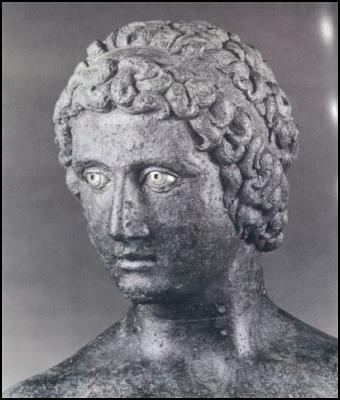
"We have a good
feeling the statue is ancient." -- Richard Newman, Head of
Scientific Research, Boston's Museum of Fine Arts (December
2006)
" I was in Sotheby's [December 1996] on my way to an old master sale, when I noticed a bronze statue of a boy perched on top of an eight foot tall French armoire. They got me a ladder and I was able to see only the toes. Under the loupe I saw immediately that the statue was ancient. It had a magnificent underwater incrustation patina, and traces of the holes which held silver toenails. I nervously descended and got the sales room frisson you get at times like this. The catalogue said 19th century bronze statue, $6 thousand to $9 thousand. Property of Sotheby's. Exhibited in the Metropolitan Museum of Art and eight others, ex collection William Herbert Hunt. I saw this thing sell six years before [at Sotheby's for half a million dollars]. What's going on?"Next day psyched up to go to seven figures I bought the bronze statue by phone for $75 thousand. The great sculpture expert Michael Hall was underbidder and was luckily tapped out at that moment. A group supposedly bid to $40 thousand planning to cut it up and sell the parts separately. The head would make $500 thousand, the torso $100 thousand, the hands and feet $10 thousand each. Everything you buy has an interesting tale, but that of the Roman boy is an odyssey. "
Advertisement - scroll to continue reading--Stuart Pivar
New York collector Stuart Pivar says the odyssey of his "nearly life-size" Roman bronze boy includes a chapter on an attempted "assassination" of the statue. He identifies the place of treachery as the Hunt-Sotheby's auction, June 19,1990. And he fingers the lead assassin: Bob Hecht.
Hecht is now on trial in Rome for another conspiracy, one to traffic in ancient art, including pieces from the Hunt-Sotheby's sale.
I covered the Sotheby's antiquities auction of the collection of Bunker and Herbert Hunt for The Economist magazine. Pivar's bronze boy statue, then owned by Herbert Hunt, was the most expensive piece on the block. Sotheby's billed it as 2nd C. AD, derived from a prototype of the 5th C. BC and estimated its value at $800,000 to $1.2 million. The catalogue noted the piece may once have been a Roman lampbearer.
The statue had been introduced to the international ancient art market in the 1970s by the late Swiss numismatist and antiquities dealer, Herbert Cahn of Munzen und Medaillen in Basle. It then went on consignment to New York dealer Andre Emmerich before being exhibited widely in the US and Hecht's partner at Summa Gallery, Bruce McNall, acquiring it.
McNall got it in Basle, almost certainly from Herbert Cahn -- although Cahn's son David says he doesn't know the details pertaining to his father's sale of the statue or where his father's files are. Quite odd, because Dr. Herbert Cahn was a scholar and his papers would likely be preserved.
In any event, McNall then sold the bronze boy to Herbert Hunt.
Pivar claims that it was Bob Hecht, the once unquestionable grand man of the antiquities trade, who spread the word in the market that the bronze was a forgery. And I do remember Hecht telling me and Turkish journalist Ozgen Acar prior to the Sotheby's sale that the statue was a fake, made in a foundry in Italy.
The other dealers took note, says Pivar, and the strength of the pack prevailed.
In a drama that must have delighted Hecht, when the piece came up for bid there was silence among the dealers. I recall a lone paddle going up and the hammer coming down rather quickly, with Sotheby's selling the bronze nude for $539,000 to an apparent outsider, a Japanese buyer. And then a snicker in the room.
That Japanese dealer is now believed to have been Noriyoshi Horiuchi - the man who supplied the Miho Museum with its hoard of unprovenanced ancient Western art.
However, even now, because of "confidentiality", Sotheby's -- a public company -- will not say who bought the bronze boy at the Hunt auction. Nor will it say whether the piece was returned with the dealer getting his money back. Nor if the statue was lab tested before the sale or who evaluated the piece prior to sale.
All we know is that somehow between 1990 and 1996 the statue became Sotheby's property. It was listed as such in Sotheby's 19th century garden sale [est. $6,000-$9,000] where Pivar bought it.
So, however you track it, the riches to rags and rags to possible riches story of the ex-Hunt Roman bronze boy clearly has been a mystery tour.
I thought I had exhausted stories related to the Hunt-Sotheby's sale, when Pivar emailed me following a recent conversation with Max Bernheim at Christie's who told him about my interview on these pages with Medici Conspiracy author Peter Watson, in which we discussed the whereabouts of the Roman boy. Krumpets With Medici Conspiracy's Peter Watson Pivar wrote:
"Dear Suzan Mazur,
I own the Roman Bronze Boy, ex Hunt coll. The story of how I got it is remarkable.
It is no fake. You are welcome to see it.
Stuart Pivar"
Cornelius Vermeule, who exhibited the statue at Boston's Museum of Fine Arts in the late 1970s when he was curator of classical art there, believed the piece was genuine too. In fact, he thought the Sotheby's estimates were low and told me so before the sale:
" Cornelius Vermeule: Very large [the Roman Bronze boy]. It's not a very beautiful work of art in terms of slick green patina kind of sinuous male or female anatomy sort of bronze that a lot of people like - of which there are others in the collection. But it's a rather powerful young man of the end of the Roman Republic/beginning of the Roman Empire slightly traditional style that goes back to the 5th Century BC.It's a splendid eclectic piece of the early Empire and it's just plain. What you call life-size or nearly life-size - 2/3rds life-size. It's kind of under life-size for a human, but it's still no sort of piccolo Bronze - no table top thing. It's, in that respect, very impressive.
Suzan Mazur: It's very much intact, is it?
Cornelius Vermeule: Yes.
Suzan Mazur: It's the most expensive piece that's going to be auctioned, I believe.
Cornelius Vermeule: Is it? I haven't looked.
Suzan Mazur: The estimate is $800,000-$1.2 million.
Cornelius Vermeule: It seems quite reasonable by today's market, considering the $1million to $2million tickets on almost every masterpiece right now and the price Mr. Herbert Hunt paid for it. The piece was on exhibit at the Museum of Fine Arts. . .
I think to quote Andre Emmerich's famous quote about the market, which goes back to Winston Chruchill - "Certain pieces are or are not the tide which raises all boats." Well this is going to be right up there surging on the beach with the best. Appropos to the Cycladic piece that Asher Edelman bought.
It [the Bronze nude] will fetch more than the estimates and the estimates are low. So in the forefront of the charge up Lookout Mountain at Gettysburg - I'm really mixing the metaphors - except I wouldn't want to lead Pickett's charge wearing what he's wearing."
Since Pivar acquired the statue in 1996, a number of experts have visited his home to view it, including a team from Sotheby's led by antiquities specialist, Dick Keresey -- who was also in charge at the time of the Hunt sale. Pivar said Keresey told him the statue was not ancient, that it resembled those bronzes manufactured from ancient molds at Chiurrazzi, a famous foundry in Naples established in 1840. That he was familiar with Chiurrazzi's catalogues.
Ironically, it was not authenticity of the Hunt items that was the burning issue surrounding the Sotheby's June 1990 auction. The concern was that the pieces were looted -- lacking provenience and provenance. This was the sale that included two signed Euphronios vases -- the first time Sotheby's had handled a piece signed by an ancient artist.
The Hunt hoard was purchased from Bruce McNall through Bob Hecht who got the pieces from Giacomo Medici. Medici has already been convicted of trafficking in antiquities by a Rome court and sentenced to 10 years; he awaits his final appeal in January.
The Euphronios Sarpedon cup Medici purchased at the Hunt-Sotheby's sale will become Italy's if he loses his appeal. And Italy is currently in discussion with Shelby White over her collection, presumably this includes the Kyknos Euphronios vase from the Hunt sale, now on loan to the Met.
Italy earlier this year reclaimed its Sarpendon Euphronios vase that Hecht sold to the Met in 1972. The masterpiece is on loan to the museum until 2008.
However, tracing the source of an unsigned bronze statue -- which may have come from a shipwreck -- is tougher than determining that a signed Euphronios vase was looted from an Etruscan tomb in Italy. Deciding a classical bronze statue's age is also more of a challenge since so few have survived to compare with.
Thermoluminescence tests can be done on a terracotta pot quite easily. Testing a bronze statue's clay remains inside from casting is not always possible. Even if there is a hole big enough to get inside without damage to rest of the piece, the core material may not be there if the statue had been "joined" rather than cast in one piece. And TL tests on core material could indicate a piece is ancient when it's not if the statue has been x-rayed a certain way prior to the TL test.
In any event, Stuart Pivar, was passionate about finding out just who his Roman Bronze boy was. He decided to have the statue evaluated and then tested in various labs.
Pivar has long been fascinated by such puzzles. He began his education at Brooklyn Technical High School. He's an inventor (plastics molding), an entrepreneur (plastics factories) and science author. He's written a book on evolution called Lifecode and was a friend of the late evolutionary biologist, Stephen Jay Gould.
He was also a close friend of the late artist Andy Warhol and co-founder with Warhol of the New York Academy of Art. In the 1980s, Pivar and Warhol frequented New York's flea markets, antique shops and auctions.

Stuart Pivar With Andy Warhol -
Image Source
Stuart Pivar now lives on New York's Central Park West in an apartment stuffed with art, which is where I first met him twenty years ago.
Pivar had thrown open his place for a fashionable 1980s party. I remember meeting him with his blonde Finnish girlfriend. He was wearing a tight velvet jacket -- his hair in ringlets framing his intense eyes.
He is still a very trim, fit 76-year old, and was wearing a muscle shirt the last time I saw him - even though he told me he now takes his gin every evening around 6pm.
I stopped by three nights in a row to view and discuss the statue. The doorman was amused asking on the third night: "Will we be seeing you tomorrow evening?"
Pivar has invested thousands of dollars since acquiring the bronze statue to discover what he's got. Some of the most important tests on the bronze have been carried out at the Boston Museum of Fine Arts -- on the materials and manufacturing process of the statue. But even so, MFA has said:
"An examination of the type carried out here rarely will absolutely prove that a sculpture is authentic or not. In the 'best case' scenario, the evidence may point strongly to the object's authenticity or lack thereof."
Therefore, the point of this story is also not to attempt to prove or disprove authenticity, but to document Pivar's investigation of the statue. Steps that should have been taken by previous owners, long before the bronze was exhibited by major museums and put on the block for a million dollars at Sotheby's.
A brief exhibition history of the piece is first, followed by Pivar's quest for the facts.
Amsterdam, CINOA Exhibition, 1972
New York, CINOA Exhibition, 1973
New York, Andre Emmerich Gallery, 1975
Boston, Museum of Fine Arts, 1978-79
Fort Worth, Texas, Kimbell Art Museum, 1983
Virginia Museum of Fine Arts, 1983
Detroit, Detroit Institute of Arts, 1984
Dallas, Dallas Museum of Art, 1984
Pivar first contacted a leading art historian at George Mason University in Washington, D.C. -- Carol C. Mattusch -- to have the statue evaluated. Mattusch is the author of The Fire of Hephaistos: Large Classical Bronzes from North American Collections. She stopped by Pivar's apartment in July 2002, and shortly after that put her observations in writing. Pivar paid her $2,500 for this.
Here are excerpts of Professor Mattusch's comments.
"This bronze is not ancient, and was almost certainly made as a forgery. Greek and Roman statues come in standard sizes and standard types. This one is neither ephebe-size, though larger than a statuette, nor adult-size.The apparent joins, horizontal lines across the arms and thighs of this bronze, are not placed where joins are made on ancient bronzes. . . . Ancient joins of naked body-parts are not at these locations, the joins are flow-welded, and there are usually patches as well in the area. . . . The nipples appear to be inset, but they do not appear to be of a different material from the surrounding metal. On an ancient statue, if nipples are inset, they are made of copper. . . . Ancient inset fingernails and toenails are silver in color. The nails on this statue do not look to me as if they are inset; the toenails look simply as if the base metal has been revealed. . . . Other problems: the dough-like wavy hair looks like what one might see on a miniature, but not on a statue of this size. . ."
However, Richard Newman, Head of Scientific Research at MFA told me that historians do not agree that classical bronzes are of a standard type. Not enough of them have survived to say so.
Following is a note about this and citing of Pivar's Roman bronze boy in Wealth of the Ancient World, the Kimbell Art Museum's catalogue on the Hunt hoard. The article was written by the late Getty Museum curator, Jiri Frel:
"Our vision today of classical sculpture is hampered by several difficulties. The literary sources are scarce and cannot always be related to the available monuments. Very few Greek bronze originals survive - the preserved marbles are considerably more numerous - which is opposite to the situation in antiquity when the majority of works were in bronze. Only three extant life-size bronzes can be directly associated with famous names: the two Riace statues with Phidias, and the Getty bronze with Lysippos.
[The Lysippos bronze statue of a "Victorious Athlete" is contested by Italy, and currently in the news. The Getty Museum claims it was found in international waters in 1964 off the coast of Italy. The Italians say that even if it was found in international waters, it was brought into Italy and smuggled out. -- LINK -- ]
The works of many other masters who sculpted exclusively in bronze are lost. Many famous bronze artists are only names. The works of others, like the masterpieces of Myron or Polykleitos from the fifth century, exist only in Roman marble copies which dilute their art even more than do marble reproductions of marble originals.Under such circumstances every large bronze is a treasure, for example, one can divine in the gauche Roman youth with inlaid silver eyes some of the inspiration from the classical ephebic beauty, even if its true starting point was the widespread image of Antinous, the emperor Hadrian's favorite."
And Jane Cody, former chair of the Department of Classics at the University of Southern California, now a USC associate dean, said this of Pivar's statue in the same catalogue:
"This figure may have originally served as a lychnouchos, or lampbearer, of the type found at Pompeii and have held a branched candle holder in each hand. Or, according to Boucher (in correspondence) [Stephanie Boucher of the Centre National de la Recherche Scientifique in France], he may have held the attributes of an athlete, the palm, as a reward for victory, in his right hand and, perhaps, a discus in his left."
So, upset but not discouraged by Mattusch's opinion, Pivar next had the bronze boy x-rayed by Tom Chase of Chase Art Services, Chevy Chase, Maryland. Chase advised him that the piece indeed had "Roman joints".
"Dear Mr. Pivar:On August 1 and 2, 2002, I examined a statue of a standing boy in your collection. After examining the statue visually, I took it out to Cranford, NJ for radiography and surface analysis using x-ray fluorescence. . . . The radiographs showed many repairs in the torso area, attachments of the head and limbs by "Roman joints," and radioopaque fills in the feet. On examiniation with x-ray fluorescence, the fills turned out to be lead. . ."
Chase told me last week that he and Pivar peered through a hole in the statue's "butt" after removing one of the patches and found there was no core material to do a thermoluminescence test on.
According to one museum source, because the statue was in pieces and then assembled, it's possible the clay could have first been removed before being joined.
Carol Mattusch, learning of the Chase test, then sent the following letter to Pivar on March 12, 2003 apparently changing her opinion about the statue:
"Dear Dr. Pivar
[Pivar says he only has a BA degree]:
Tom Chase forwarded your letter to me of March 11, which you sent to him. I know Richard Stone, and I am glad that he looked at your ex-Hunt bronze statue of a boy.
[Pivar said Stone never gave him a written evaluation but casually looked at the piece at his home.]
If he and Tom Chase believe it to be ancient, I see no reason that you should not accept their word. Nor do I think that you need to ask me to look at the statue again: simply accept their conclusions.I remind you that you never paid me the full amount that you offered for my consulting work on July 5, 2002."
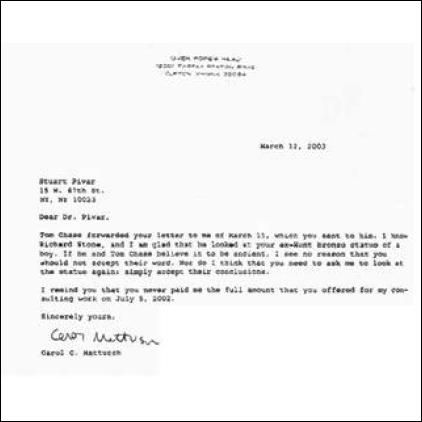
I have since had email exchanges with Carol Mattusch, confirming that she did evaluate the bronze for Pivar, although she would not say exactly what she wrote. She also did not respond to my email request for a conversation about the matter, however, I have copies of both her evaluation and her March 12, 2003 letter.
Next, the Boston MFA asked Pivar to exhibit the piece in their 2004 show to celebrate the Olympics in Greece that summer: "The Greek Athlete and the Games". MFA officials saw Pivar's bronze boy as an "athletic victor". They asked to test the statue in their lab to try to verify its ancientness before exhibiting.
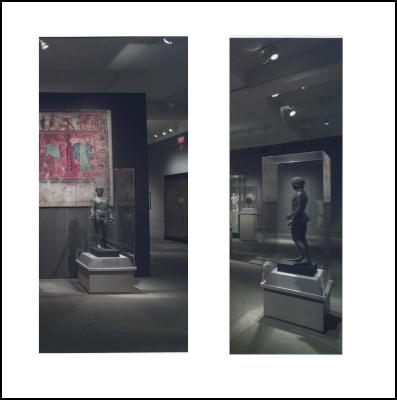
Click for big version
Boston MFA's "The Greek Athlete And The Games" Exhibition Of Bronze Boy As "Athletic Victor"
MFA will only run such tests for a collector or dealer if the museum plans to exhibit their art. Pivar paid for the MFA tests and all other testing of his bronze.
MFA also required an appraisal, which Pivar secured from the National Association of Dealers in Ancient, Oriental & Primitive Art. This was the organization that Fred Schultz was president of before he was convicted for conspiring to smuggle Egyptian antiquities. -- LINK -- NADAOPA filed a friend-of-the-court brief in 2001 opposing Schultz's indictment, but the dealer was sentenced and went to jail.
On March 20, 2004, NADAOPA cited the insurance value for Pivar's Roman bronze boy at $1million. The document was signed by Astrid Sanai, Director of Appraisal Services.
NADAOPA does not seem to have a website. There are a couple of references online about reaching the organization through the Merrin Gallery. But the receptionist at Merrin said the gallery stopped appraising for NADAOPA about 15 years ago. That would be roughly around the time of the Hunt-Sotheby's sale. I was given a telephone number for Astrid Sanai, however, there was only a voice message at that number.
No one from NADAOPA returned my call regarding my question as to who on the NADAOPA committee appraised Pivar's statue in March 2004. I was particularly interested in finding out because none of the New York dealers bid on the statue at the 1990 Sotheby's auction.
After Pivar succeeded in getting the $1million appraisal, MFA told Pivar the statue had "bronze disease" and needed cleaning before it could be exhibited. This was done at one of MFA's outside labs in Massachusetts.
MFA scientists then studied Tom Chase's x-ray radiographs of the piece and made their own observations. They confirmed Chase's findings that the joins were mechanical -- with three pins in each join -- and noted that mechanical joins were used by the Romans.
MFA found "little evidence" of intergranular corrosion in the samples they took in the more accessible, less corroded areas of the Bronze. They did not want to slice into areas that had more corrosion (the head) because they did not want to further disturb the piece. Richard Newman said, however, that he did not need evidence of more significant intergranular corrosion to say that MFA had a "good feeling" the Roman bronze boy was ancient.
Here are some of MFA's findings:
- The standing youth was made in six pieces, which appear to have been joined by mechanical means [sleeve and pin]. Large classical bronzes were usually made in multiple pieces, similar to the manner in which the "standing youth" was made. The usual means of joining pieces were fusion welding and mechanical joins (the latter aided sometimes with lead solder).- The standing youth was made from an alloy that contained intentional amounts of tin, zinc and lead. . . . Bronze alloys that contain as much zinc as the standing youth . . . were utilized by the Romans, particularly for everyday metalwork such as lamps, hinges, etc.
- Silver inlays were used in the eyes and copper (or copper alloy) inlays in the nipples. Such inlays were fairly common in Roman statuary. . . . No silver was detected [in samples from a fingernail and toenail, copper corrosion products were].
- Metallographic sections, taken from areas in which little corrosion was evident, showed little evidence of intergranular corrosion. There were, however, pockets of thick corrosion in recessed areas in the sections, even though most of the exposed surfaces contained no corrosion.
- The presence of chlorides on presumed cleaned areas and in areas of thicker corrosion suggest that the statue may have been buried in seawater.
- Samples of the thicker black [corrosion] were chipped with a scalpel from one toenail on each of the feet and from one location in the hair. These chips were prepared as polished cross sections and examined by Scanning Electron Microscope. The analyses showed that all three samples contain compact corrosion which has a complex structure involving numerous superimposed layers whose relative copper and tin contents are variable.
Pockets of lead corrosion products (probably carbonate) are scattered throughout the cross sections. Chlorides are present (but not evenly distributed) throughout all three of the cross sections.
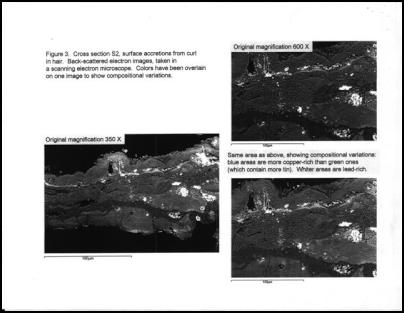
Click for big version
So does anyone really know what they're buying at an auction of ancient art or from an antiquities dealer unless certain lab tests have been carried out? And even if a piece has been tested, how conclusive can the data be?
Says Met Ancient Near East expert Oscar White Muscarella, who has also seen the Roman bronze boy at Stuart Pivar's place:
"Conclusions presented by conservators citing their "scientific" investigations can be as subjective, wrong, or in conflict with fellow scientists' conclusions, as empirical , non-scientific determination by archaeologists and art historians. The assumption that alleged "subjective" stylistic analyses is distinct from alleged "objective" scientific analysis is a false dichotomy. Both forms of analyses are subject to fallibility, ignorance, mistakes, and more.
To quote an honest conservator: "we have no magic machines."
And pertaining to common academic perceptions of scientists or conservators employed by private collectors and museums to make determinations about authenticity, two issues are to be emphasized. One is that they can honestly err in their conclusions. And more important, because it is little known or discussed, a number are not disinterested agents as they and their employers proclaim, for they obey the commands (overt or insinuated), or seek to please the anticipated needs, of their paymasters. Put bluntly and succinctly: some conservators when recognizing they are indeed examining a forgery will refrain from making a complete, thorough analysis, and present general, non-significant observations, or consciously omit conducting a complete, thorough analysis, crucial tests that would demonstrate that the object is a modern creation. They then lie about the results of their alleged analyses by making general statements, and/or ambiguous, dissimulating conclusions-attesting to the ancient manufacture of the object."
But Pivar, who has lived with the Roman bronze boy for 10 years, now having exhausted most of the methods of testing the piece, has no doubts about it being genuine. What's more, he says Sotheby's by presumably returning the half million dollars to the Japanese dealer may have shown negligence in regard to its stockholders.
 Suzan
Mazur's stories on art and antiquities have been published
in The Economist, Financial Times, Connoisseur, Archaeology
(cover) and Newsday. Some of her other reports have
appeared on PBS, CBC and MBC. She has been a guest on
McLaughlin, Charlie Rose and various Fox Television News
programs. Email:
sznmzr@aol.com
Suzan
Mazur's stories on art and antiquities have been published
in The Economist, Financial Times, Connoisseur, Archaeology
(cover) and Newsday. Some of her other reports have
appeared on PBS, CBC and MBC. She has been a guest on
McLaughlin, Charlie Rose and various Fox Television News
programs. Email:
sznmzr@aol.com


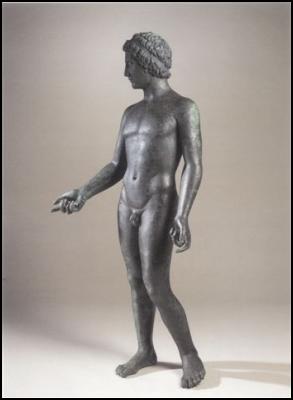
 Binoy Kampmark: Rogue States And Thought Crimes - Israel Strikes Iran
Binoy Kampmark: Rogue States And Thought Crimes - Israel Strikes Iran Eugene Doyle: The West’s War On Iran
Eugene Doyle: The West’s War On Iran Richard S. Ehrlich: Deadly Border Feud Between Thailand & Cambodia
Richard S. Ehrlich: Deadly Border Feud Between Thailand & Cambodia Gordon Campbell: On Free Speech And Anti-Semitism
Gordon Campbell: On Free Speech And Anti-Semitism Ian Powell: The Disgrace Of The Hospice Care Funding Scandal
Ian Powell: The Disgrace Of The Hospice Care Funding Scandal Binoy Kampmark: Catching Israel Out - Gaza And The Madleen “Selfie” Protest
Binoy Kampmark: Catching Israel Out - Gaza And The Madleen “Selfie” Protest